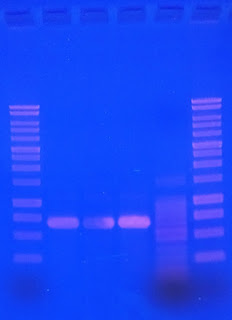Lab Meeting 3: Trillium Breakthrough!
 |
| Trillium grandiflorum rbcL PCR |
Science isn't always pretty. This is only the third "Lab Meeting" post I've done this semester. I was hoping to update a lot more often, but sometimes there are unforeseen problems that need to be ironed out and things slow down. This is definitely one of those occasions. We've been hacking away at a baffling PCR problem for the last month or so, and we've only just resolved it.
I mentioned previously that one of our projects was to study flower genes in trilliums. Trilliums are a really interesting species group, and there are many different species here in the southeast. We've been looking very closely at a mutant trillium that has only petals for flower parts. My intern and I want to find the genes that control flowering from trillium specimens that we collected this past summer, and for us, that involves a process call Polymerase Chain Reaction (PCR). PCR is like a copy machine for DNA. You put an original piece of DNA into the PCR machine, and it will produce zillions of copies. Because we're dealing with tiny molecules too small to actually see, we need zillions of copies so that we can see our results (literally).
After designing the PCR experiment the first half of the semester, we started working on the actual PCR. As I said, the results were baffling because we weren't getting any results, which didn't make any sense. Monday night, we finally figured out what the problem was (It was the transilluminator! Of course!), and that was our little breakthrough for the semester. (Truth be told, it actually felt like a big breakthrough, but we try to keep things in perspective!)
So just before Christmas break, we finally got to see some trillium DNA! That's what's in the picture at the top of the page. Those blurry little pink lines are where the DNA is. The pink color is from soaking the DNA in a special chemical that makes it glow under black light. The three bright lines right in the middle of the picture (without any lines above or below) are the trillium DNA. In this PCR experiment, we were looking for a common gene (rbcL) from a sample of large-flowered trillium (Trillium grandiflorum) to test whether our specimens were good and our PCR worked. As you can see, it worked GREAT! Now we can start looking for those flower genes I've been talking about. This is where it gets really fun!
I want to thank all the donors to Core Academy that made this research possible. Our student interns are especially excited during this holiday season (finally getting DNA), and I wanted to share that excitement with you! If you would like to help support our student scientists, please click on that donate button at the end of this post or visit Core Academy's website to find out more. This week at Core Academy, we have a special challenge gift of $2,000, so your contributions can be doubled. If you've been considering a gift to Core Academy, this would be the week to do it!
Feedback? Email me at toddcharleswood [at] gmail [dot] com. If you enjoyed this article, please consider a contribution to Core Academy of Science. Thank you.